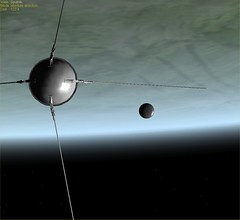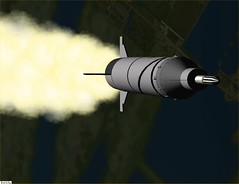

Beep. Beep. Beep. That was the sound that kick-started the Space Age on October 4, 1957 (my Mom's 25th birthday - I was four). Of course that was the radio signal from Sputnik 1, the first man-made satellite, launched that day by the Soviet Union. Trying to quickly catch up, the US attempted to launch the Navy's Vanguard satellite on December 6, 1957. It spectacularly and publicly blew up on the pad, earning it the nickname "Kaputnik," among many others. But on January 31, 1958, the US successfully launched the small JPL-built Explorer 1 into orbit, using the Army's Redstone-derived Juno booster (the launch was not announced ahead of time). Redstone in turn had been developed by Wernher von Braun and his Army rocket development team from the German V-2, a number of which had been captured at the end of WW2 and used to accelerate the Army's rocket development programs.
Explorer 1 was small and simple, but it did more than beep - data from its cosmic ray particle detector led to the discovery of the Van Allen radiation belts, a very significant scientific accomplishment for America's first satellite. Of course the Soviets were doing science in space too - Sputnik 2 (November 1957) carried several scientific experiments as well as Laika the dog. Laika adapted well to space, but there was no provision for controlled re-entry on this flight. After a week of monitoring her vital signs by telemetry, she was given a remote-controlled lethal injection.
Of course you know all this, and so do I, but now I know it even better thanks to several well-written and detail-rich early history chapters I've just read in This New Ocean by William Burrows. I've left out the historical and political context here, though this is important and is a major strong point of this book. While there are many technical details and a fair number of pictures in the book, reading about these "early bird specials" made me want to see them and launch them for myself in Orbiter. So I installed a few add-ons, V-2/Bumper by Robert Conley and Brian Sikemma; Sputnik by Manuel Amorim; Explorer 1 by Jim Williams; and a version of Vanguard 1 announced recently by Dave413 on the Orbiter forum, and supplied by him with actual current Vanguard orbital elements.
Current? Yes, Vanguard 1 finally made it to orbit in 1958, and it remains in orbit today, the oldest man-made object still in space.
Orbiter pix show Sputnik in Orbit and Explorer 1 climbing out above Florida (see more on Flickr). No background web links in this post since I am writing "off line" - my only web access at this conference in India is a shared "cyber cafe" which is in heavy demand and seems to go down every few minutes. So I gotta be quick!
3 comments:
Bruce,
You should publish "The Orbiter Accompaniment to This New Ocean." You're off to a good start!
hahaha :D great idea :)
check this out Bruce:
www.fusiononline.com/nasa_esas.htm
Post a Comment